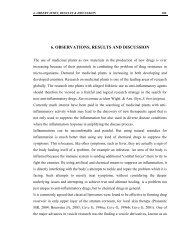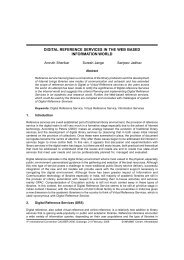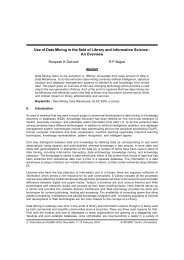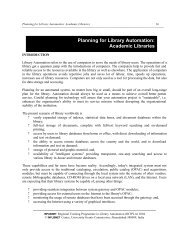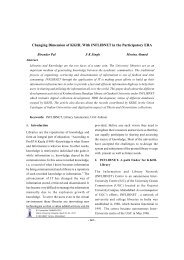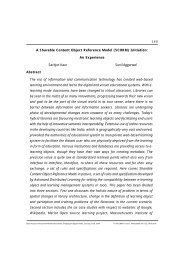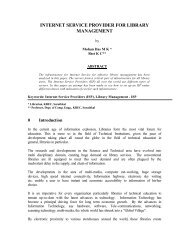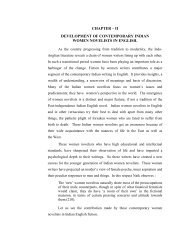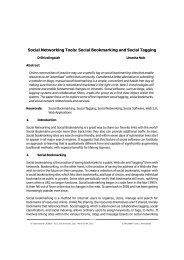Digital Preservation of Indian Manuscripts - INFLIBNET Centre
Digital Preservation of Indian Manuscripts - INFLIBNET Centre
Digital Preservation of Indian Manuscripts - INFLIBNET Centre
Create successful ePaper yourself
Turn your PDF publications into a flip-book with our unique Google optimized e-Paper software.
370<br />
<strong>Digital</strong> <strong>Preservation</strong> <strong>of</strong> <strong>Indian</strong> <strong>Manuscripts</strong> - An Over View<br />
Y V Ramana<br />
Abstract<br />
This paper presents a brief over view <strong>of</strong> <strong>Digital</strong> <strong>Preservation</strong>, Digitization <strong>of</strong> manuscripts<br />
and preservation techniques which are currently in use in India. The role <strong>of</strong> the National<br />
Library <strong>of</strong> India in <strong>Digital</strong> <strong>Preservation</strong> <strong>of</strong> <strong>Indian</strong> <strong>Manuscripts</strong> is highlighted. It also deals<br />
with the Manuscript Resource Centers and Manuscript Conservation Centers <strong>of</strong> India. The<br />
requirements <strong>of</strong> <strong>Digital</strong> <strong>Preservation</strong> are presented in this paper.<br />
Keywords : <strong>Digital</strong> <strong>Preservation</strong>, <strong>Manuscripts</strong>, Digitization.<br />
0. Introduction<br />
India possesses one <strong>of</strong> the ancient and richest cultures <strong>of</strong> the world. India has the largest collection <strong>of</strong><br />
manuscripts, containing ancient culture and knowledge representing thousands <strong>of</strong> years <strong>of</strong> history. The<br />
<strong>Indian</strong> manuscripts, which were written in different languages and scripts are preserved on treated Palm<br />
leaves, Birch barks, Silk cloth, Wood, Tamra Patras and hand made paper, inscriptions on stone etc.<br />
They are spread all over the country and abroad and are preserved in libraries, museums, temples,<br />
Mutts, monasteries etc. These manuscripts contain invaluable knowledge in medicine, science and<br />
mathematics, literature, art and architecture, theology, philosophy, music and dance etc. These sources<br />
not only provide information on these subjects, but also throw light on the history and culture <strong>of</strong> the nation.<br />
In the past as a result <strong>of</strong> natural calamities like floods, wars, fire, and foreign invaders a good collection<br />
<strong>of</strong> old manuscripts were destroyed. <strong>Manuscripts</strong> and other old documents have been conserved with<br />
other artifacts like buildings, sculptures, paintings, monuments etc. Now the concept <strong>of</strong> preservation has<br />
changed. The manuscripts are preserved with the modern digital technology by converting to Analog or<br />
<strong>Digital</strong> copies <strong>of</strong> the original. At present the preservation techniques are coupled with the word Access,<br />
which is to provide information to those who need it in shortest possible time, with the new technologies<br />
like Internet, CD-ROM etc.<br />
1. <strong>Digital</strong> <strong>Preservation</strong><br />
<strong>Digital</strong> preservation refers to a series <strong>of</strong> managed activities, which are necessary to ensure continued<br />
access <strong>of</strong> digital materials for as long as they are necessary. The term digitization refers to the conversion<br />
<strong>of</strong> material that was originally created in another form to digital form (i.e. which uses a binary numerical<br />
code to represent variables). The ultimate goal <strong>of</strong> preservation is to make the intellectual content to<br />
remain in tact as long as possible. The idea <strong>of</strong> protecting the original documents by reproducing it on a<br />
stable media gave rise to digitizing the maps, manuscripts, moving images, music and sounds etc.<br />
Digitization <strong>of</strong> the old and fragile material will not only provide long time preservation but also <strong>of</strong>fers the<br />
users to find, retrieve, study and manipulate the information in a colorful environment.<br />
Modern multimedia technology is playing a major role in preservation and promotion <strong>of</strong> cultural heritage,<br />
by digitizing all forms <strong>of</strong> materials, text, visual, audio/video moving pictures etc. together to represent the<br />
holistic form. The World Wide Web is wide reaching medium through which anything and everything<br />
could be made available to anyone and everyone around the globe, in fastest way.<br />
3rd International CALIBER - 2005, Cochin, 2-4 February, 2005, © <strong>INFLIBNET</strong> <strong>Centre</strong>, Ahmedabad
Y V Ramana<br />
371<br />
2. Digitization <strong>of</strong> <strong>Manuscripts</strong><br />
India has one <strong>of</strong> the largest and oldest collections <strong>of</strong> manuscripts in the world. To day the Palm leaf<br />
books, paper manuscripts, birch bark texts, drawings, paintings, art and sculpture etc. are either scanned<br />
or converted into analog material and are preserved on long lasting digital media for the use <strong>of</strong> future<br />
generations. The most important benefits <strong>of</strong> digital preservation are:<br />
? <strong>Preservation</strong> : <strong>Digital</strong> reproductions are virtually immortal in the sense, by reproducing multiple<br />
digital copies and by putting them for use the originals can be protected. By digitizing the<br />
manuscripts, the information can be preserved for a long time on digital media. The paintings and<br />
photos etc. <strong>of</strong> rare manuscripts can be enlarged and reproduction in the colorful environment is<br />
possible with digital technology.<br />
? Dissemination <strong>of</strong> Information : Most <strong>of</strong> these manuscripts are stored in museums, libraries,<br />
temples and Mutts etc. with a restriction to use them. The digital preservation is not only safeguarding<br />
the original documents, but also providing these documents for information dissemination and<br />
research purpose via internet and CD-ROM etc.<br />
? Transcend Originals : <strong>Digital</strong> imaging promises to generate a product that can be used for purposes<br />
that are impossible to achieve with original resources. It uses special lighting to draw out details<br />
obscured by aging, use, and environmental damage. Imaging, which makes use <strong>of</strong> specialized<br />
photographic intermediaries or by imaging at high resolution the study <strong>of</strong> artifactual characteristics<br />
has become possible.<br />
? Collection Management : <strong>Digital</strong> preservation provides assistance in retrospective cataloguing,<br />
researching, assistance with curatorial functions, managing material movement etc.<br />
? New Revenue Streams : By making available the digital reproductions at lower resolution to<br />
scholars as a paid service, sale <strong>of</strong> high quality posters to art patrons around the world via an e-<br />
commerce web site it is possible to generate some revenue.<br />
3. <strong>Preservation</strong> <strong>of</strong> <strong>Manuscripts</strong> in India<br />
Even under the best possible conditions, the physical preservation <strong>of</strong> manuscripts is a difficult task. The<br />
cultural heritage <strong>of</strong> India, in the form <strong>of</strong> manuscripts has to be conserved, preserved and documented.<br />
With this motivation, from ancient times preservation <strong>of</strong> manuscripts is done by indigenous methods like<br />
wrapping the manuscripts in silk cloth. Some times oil extracts <strong>of</strong> some natural products, sandal wood<br />
powder, black pepper, clove oil etc. are used for preserving palm leave manuscripts. Chemical treatments<br />
like, fumigation chambers and Thymol, Chloromate solution are also used to protect the manuscripts.<br />
The Photographic methods, like micr<strong>of</strong>iche, micr<strong>of</strong>ilming, photocopying are very important techniques <strong>of</strong><br />
preservation and access. This method not only may damage the originals but preserve them only for a<br />
few decades.<br />
The invention <strong>of</strong> Scanners has revolutionized the input <strong>of</strong> data to computer media, which can also<br />
damage the manuscripts. Then high-definition film scanner is used to digitize the manuscript as image,<br />
which is an expensive method. Before 1998, digital cameras were used, which could copy only a few<br />
pages and turns out to be quite expensive.<br />
From 1999, improved still cameras are used to meet the needs <strong>of</strong> in-house digital copying. National<br />
Institute <strong>of</strong> Advanced Studies (NIAS) used this method by digitizing Bhagavad Gita into two CD-ROMs.<br />
The availability <strong>of</strong> Bhagavad Gita in digital form and its inclusion in computer database has rendered its<br />
access through Internet.
372<br />
<strong>Digital</strong> <strong>Preservation</strong> <strong>of</strong> <strong>Indian</strong> <strong>Manuscripts</strong> : An Overview<br />
NIAS started a new method <strong>of</strong> preservation called NiDAC, to share the rare manuscripts via the Internet<br />
or CDs, for educational and research purposes. Instaed <strong>of</strong> using a scanner to digitize each page as a<br />
computer graphic, the NiDAC procedure begins with the DV video format. The DV video format simply<br />
records everything in binary code onto a mini DV tape. The Camcorder connects to high end computers<br />
via an IEEE1394 cable and card. The digital image can be manipulated as a graphic or converted into<br />
alphanumerical list. Images will be compressed into JPEG image formats and the computerization is<br />
completed with various forms <strong>of</strong> storage like rewritable media, CDs etc. The NiDAC also used a megapixel<br />
digital still camera with extra large memory cards and this method is one <strong>of</strong> the cost effective<br />
methods and it is ten times faster than downloading via a parallel or serial cable. This method is superior<br />
to the DV digitization and also works for extended field trips to archives, if a laptop or a computer with<br />
adequate storage is available. The NiDAC procedure allows in house copying <strong>of</strong> acid paper books such<br />
as yellowed and crumbled books. In the NiDAC procedure, DV (<strong>Digital</strong> Video) video format simply records<br />
everything as binary code on to a mini DV tape. DV digitizing method can be utilized for work in remote<br />
archives for extended times with no computer access and uncertain power supply etc.<br />
4. Role <strong>of</strong> National Library <strong>of</strong> India<br />
The National Library <strong>of</strong> India, located in Kolkata is collecting, disseminating and preserving the national<br />
heritage <strong>of</strong> the country. Digitization <strong>of</strong> manuscripts is one <strong>of</strong> the initiatives the library has taken up with its<br />
own holdings. The National Library <strong>of</strong> India holds the following manuscripts:<br />
? Paper manuscripts 3,000 volumes<br />
? Correspondence and diaries 250 volumes<br />
? Palm leaf manuscripts 334 volumes<br />
? Persian 955 volumes<br />
? Arabic 681 volumes<br />
? Bengali 168 volumes<br />
? English 255 volumes<br />
? Hindi 5 volumes<br />
? Tamil 370 volumes<br />
? Sanskrit 790 volumes<br />
100 volumes <strong>of</strong> Xylographs, comprising more than 800 items (which are presented by honorable Dalai<br />
Lama) are block prints made from the bark <strong>of</strong> rare Nepali trees. The Arabic and Persian manuscripts<br />
bear beautiful illustrations, fine calligraphy and elegant binds.<br />
As a sample project the Persian manuscript Tutinamah was chosen by the National Library for digitization.<br />
This manuscript consists <strong>of</strong> well known 52 tales <strong>of</strong> a parrot written in <strong>Indian</strong> Taliq within gold and color<br />
ruled borders and contains colored illustrations made through vegetable and organic dyes, on a hand<br />
made paper.<br />
5. The Process <strong>of</strong> Digitization<br />
The National Library <strong>of</strong> India carried out the digitization project in two operational areas. They are
Y V Ramana<br />
373<br />
Image Capture Station : The Image capture station consists <strong>of</strong> a digital camera ( Nikon D100 with<br />
Bayonet mount 28-70mm f/2.8 ED-IF AF-S Zoom-Nikkor lens) mounted vertically on the photographic<br />
copystand with side illumination through 40 watts incandescent lamp. The digital camera had special<br />
colorimetric filters that enabled the camera to capture a broader spectrum <strong>of</strong> colors than the scanners.<br />
Image Processing Station : It is a HP Brio Pentium – IV processor, having image processing s<strong>of</strong>tware<br />
like, Kodak, Imaging, Adobe Photo shop –6 etc. The image transfer device, which is connected to the USB<br />
port, gathers images from the memory card <strong>of</strong> the digital camera.<br />
Process : While taking care <strong>of</strong> the condition <strong>of</strong> the document, page number orders etc. the lighting is<br />
adjusted using light meter.<br />
Image capture : The images were taken for all right handed side pages first, and then left handed pages,<br />
in color as uncompressed 8 – bit per channel (24 bit RGB) TIFF files at 300 dpi.<br />
The Image processing<br />
The images were first transferred to the image processing station, where they were renamed as per the<br />
page sequence and checked for their quality with the originals. Later they were edited and converted into<br />
three basic formats like PDF (Portable Document Format), which can describe documents containing<br />
any combination <strong>of</strong> text, graphics and images in a device independent and resolution independent<br />
format, TIFF (Tagged Image File Format), which is a file format used for still – image bitmaps, stored in<br />
tagged files) JPEG (Joint Photographic Exports Group). The JPG file is small and compressed by 90% <strong>of</strong><br />
the original size. Finally, the manuscript is put in E-Book Format, in which the PDF image files were<br />
tagged and a composite PDF file is prepared as per the original document pagination and sequence.<br />
The composite PDF containing the individual pages were in E-Book form, with the object <strong>of</strong> access. The<br />
images were stored in CD-ROM and were made resident in hard disk <strong>of</strong> the central server.<br />
6. Manuscript Resources <strong>of</strong> India<br />
? Total number <strong>of</strong> <strong>Manuscripts</strong> in India 5,000,000<br />
? <strong>Indian</strong> <strong>Manuscripts</strong> available in European countries 60,000<br />
? <strong>Indian</strong> <strong>Manuscripts</strong> in Asian countries 150,000<br />
? Percentage <strong>of</strong> manuscripts in Sanskrit 67%<br />
? Percentage <strong>of</strong> manuscripts in other <strong>Indian</strong> languages 25%<br />
? Percentage <strong>of</strong> manuscripts in Arabic /Persian/Tibetan 8%<br />
? No. <strong>of</strong> manuscripts recorded in catalogue 1,000,000<br />
Out <strong>of</strong> these Indira Gandhi National Center for Arts ( IGNCA) has 2,50,000 manuscripts, <strong>Indian</strong> National<br />
Trust for Art and Cultural Heritage (INTACH) has surveyed more than 300 sites in 3 districts and prepared<br />
an inventory <strong>of</strong> 47,000 palm leaf and paper manuscripts.<br />
7. Mission for <strong>Digital</strong> <strong>Preservation</strong> <strong>of</strong> <strong>Manuscripts</strong><br />
The National Mission for manuscripts was launched by the Department <strong>of</strong> Culture, Ministry <strong>of</strong> Tourism,<br />
Government <strong>of</strong> India, with the Indira Gandhi National Center for Arts as the national nodal center to save<br />
the India’s most valuable heritage. It selected four agencies for digitizing manuscripts in 5 states <strong>of</strong> India.<br />
They are :
374<br />
<strong>Digital</strong> <strong>Preservation</strong> <strong>of</strong> <strong>Indian</strong> <strong>Manuscripts</strong> : An Overview<br />
1. NIC, New Delhi, Illustrated <strong>Manuscripts</strong> <strong>of</strong> Orissa.<br />
2. MSP, Bangalore, Siddha <strong>Manuscripts</strong> <strong>of</strong> Tamil nadu.<br />
3. CDIT, Delhi, Kuddiyattam <strong>Manuscripts</strong> <strong>of</strong> Kerala<br />
4. CIL, New Delhi, Kashmir <strong>Manuscripts</strong> <strong>of</strong> Ikbal Manuscript Library.<br />
5. NIC, New Delhi, Vaishanava <strong>Manuscripts</strong> <strong>of</strong> Majuli Island, Assam.<br />
8. Manuscript Resource Centers<br />
The Mission has selected 24 Manuscript Resource Centers (MRC) in the country for coordinating its<br />
activities pertaining to survey and documentation <strong>of</strong> manuscripts. These centers are registered libraries,<br />
museums, oriental institutions, universities etc. with considerable manuscript holdings and necessary<br />
infrastructure to provide support for survey, documentation and digitization <strong>of</strong> manuscripts. Strategies for<br />
cataloguing, preservation and storage <strong>of</strong> manuscripts is drawn in consultation with the experts and<br />
evolved a standard format for the preparation <strong>of</strong> a comprehensive national electronic registration <strong>of</strong><br />
manuscripts.<br />
9. Manuscript Conservation Centes<br />
The mission has identified 15 Manuscript Conservation Centers (MCC) all over the country as nodal<br />
centers for preservation and conservation <strong>of</strong> manuscripts. MCC are to provide training in preservation<br />
and conservation, taking up the task <strong>of</strong> conservation <strong>of</strong> manuscripts in different institutions, work for<br />
introducing the new technologies for conservation <strong>of</strong> manuscripts. Some <strong>of</strong> the MCCs are:<br />
? Indira Gandhi National Center for Arts, Delhi<br />
? Orissa Art Conservation Center, Bhubaneswar<br />
? Rampur Raja Library, Rampur, U.P<br />
? Saraswati Mahal library, Thanjavur<br />
? Salarjung Musuem, Hydarabad<br />
? Khuda Baksh Library, Patna<br />
? Rajasthan Oriental Research Institute, Jodhpur<br />
? Oriental Institute, M.S. University, Baroda<br />
? INTACH, Chitrakala Parishat, Bangalore<br />
? Bhandarkar Oriental Research Institute , Pune. Etc.<br />
All these centers are well equipped with conservation laboratories and have expertise in providing<br />
conservation and preservation services for manuscripts.<br />
National Electronic Register: The mission started for evolving a National Electronic Data base <strong>of</strong><br />
manuscripts, which integrates information regarding different aspects <strong>of</strong> manuscripts like, type <strong>of</strong> material,<br />
script, language, subject, place <strong>of</strong> availability, illustrations, number <strong>of</strong> pages etc. The database integrates<br />
information regarding the organizations with their manuscript holdings, catalogues in the country and<br />
abroad, along with the bibliographical details <strong>of</strong> the manuscripts. National Informatics Center prepared<br />
the s<strong>of</strong>tware and data for 20,000 manuscripts are entered in the database. A copy <strong>of</strong> the s<strong>of</strong>tware is given<br />
to MRCs and the work <strong>of</strong> entering the Meta data is started in these centers.
Y V Ramana<br />
375<br />
10. Institute <strong>of</strong> Asian Studies Project<br />
A study by Institute <strong>of</strong> Asian Studies, Madras indicates that there are about one hundred thousand palm<br />
leaf manuscripts, in Tamil language in south <strong>Indian</strong> Repositories and are lying in a destroyed shape.<br />
These manuscripts are related to subjects like Siddha, Ayurveda, Yunani, Human anatomy, Art &<br />
Architecture, Temple art, Ship building, Carpentry, Metal working, Astrology & Astronomy, Yoga, Martial<br />
arts, Physiognomy etc. The institute deputed a team <strong>of</strong> highly qualified specialists for the task <strong>of</strong><br />
preservation <strong>of</strong> these manuscripts. As a first step the team identified, collected and conserved the<br />
manuscripts and then micr<strong>of</strong>ilmed and preserved the manuscripts. In the second step, these manuscripts<br />
are translated, edited and catalogued.<br />
Digitization : An international team <strong>of</strong> scholars from Germany, University <strong>of</strong> Cologne, University <strong>of</strong> Berkeley,<br />
U.S.A, are working in collaboration with Online Tamil Lexicon project, to digitize the manuscripts and after<br />
digitization, they will be disseminated as online databases, CD-ROMs and conventional publications as<br />
books.<br />
11. <strong>Digital</strong> <strong>Preservation</strong> Requirements<br />
<strong>Digital</strong> preservation encompasses a broad range <strong>of</strong> activities designed to extend the usable life <strong>of</strong><br />
machine readable computer files and protect them from media failure, physical loss and obsolescence.<br />
<strong>Digital</strong> preservation will add little values to the research process if it serves only as an alternative form <strong>of</strong><br />
storage. Preserving digital materials in formats that are reliable and usable will require long term<br />
maintenance <strong>of</strong> structural characteristics, descriptive Meta data, display and computational and analytical<br />
capabilities, which demand mass storage and s<strong>of</strong>tware for retrieval and interpretation. The digital<br />
preservation is a process that requires the use <strong>of</strong> the best available technology, careful thought,<br />
administrative policy and procedures.<br />
12. Conclusins<br />
<strong>Preservation</strong> <strong>of</strong> manuscripts is not new in India. Along with traditional methods <strong>of</strong> preservation, modern<br />
techniques <strong>of</strong> digital preservation are also adopted. The Government <strong>of</strong> India is trying to preserve its<br />
cultural heritage by proposing strategies and policies at national level. By giving the responsibility <strong>of</strong> the<br />
conservation and preservation to National Library, National Informatic Center, National Archives and<br />
many individual libraries and information centers in the country. But the invaluable manuscripts <strong>of</strong> India<br />
are scattered among libraries, museums, temples, individuals etc. <strong>of</strong> the country and aboard. Therefore,<br />
it is the responsibility <strong>of</strong> each <strong>of</strong> these institutions to preserve them with modern digital technologies.<br />
The present technology and available expertise is enough to digitize the existing manuscripts, but one <strong>of</strong><br />
the important limiting factors is motivation and monetary support, which should come from private business<br />
houses, religious bodies and individuals and a system <strong>of</strong> sharing the benefits should be worked out<br />
among owners <strong>of</strong> manuscripts, sponsors and universities.<br />
13. References<br />
1. www.library.cornell.edu/iris/tutorial/terminology/preservation.htm<br />
2. National mission <strong>of</strong> manuscripts, namami.nic.in<br />
3. http://gistnic.ap.nic.in/san/<br />
4. www.ndl.go.jp./en/publicaton/cdnlao/047/473.html<br />
5. http://xlweb.com/heritage/asian/index.htm<br />
6. http://www.tifac.org.in/abt/ab/.htm
376<br />
<strong>Digital</strong> <strong>Preservation</strong> <strong>of</strong> <strong>Indian</strong> <strong>Manuscripts</strong> : An Overview<br />
About Author<br />
Mrs. Y V Ramana is currently working as an Assistant Librarian at Vellore<br />
Institute <strong>of</strong> Technology, Vellore in Tamilnadu.She has about 12 years <strong>of</strong> experience<br />
as Assistant Librarian in various Institutes <strong>of</strong> Engineering & Technology. She<br />
holds MA (Soc.), MA (AIH&C), MLISc. She has contributed number <strong>of</strong> papers<br />
in seminars and conferances.<br />
E-mail : yvramana58@yahoo.co.in




